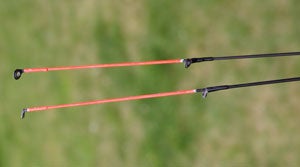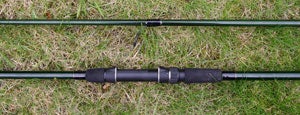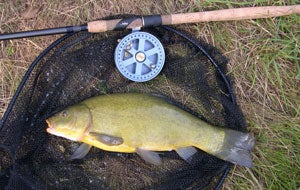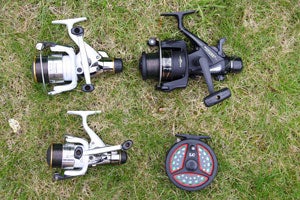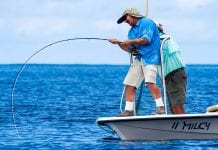| MARK WINTLE | |
|
Beginner’s Essentials 3 – Rods and Reels
Any well-stocked tackle shop has dozens of different rods and reels but which are which? Why do some rods cost hundreds of pounds and others cost less than a tenner? Why are some rods very long and others much shorter? Why do reels vary in size as well as type? Let’s start with rods. RODSFishing rods have several purposes. They provide a flexible lever to cast the end tackle or rig to where we want to fish. They provide a cushion to the struggles of the fish when playing them after hooking, and help keep the hooked fish from reaching weeds and other snags. They provide a means to tighten the line quickly to set the hook when we have a bite, and may even detect that bite in the first place. Finally they may help in controlling the tackle whilst fishing. The longer a rod the better it may be for controlling the end tackle or keeping hooked fish out of snags but it will also be heavier and more tiring to use. The length of a rod is a compromise of these design ideals.
Because of these different purposes the design of a fishing rod is a compromise but through the decades of development different rods have evolved for each style of fishing that are judged to be well suited to each task.
Floatfishing Floatfishing requires fairly short casts, plenty of line control and the ability to hit a bite. That means the rod should be light in weight, fairly long and matched to fine lines. Rods for floatfishing are either described as such – ‘float rod’ or as a ‘match rod’. Typical length is 13 feet or 3.9 metres. The reel fitting is near the top of the handle and the rod rings are small and lightweight. These rods are three piece, ie, two joints. As with other rods you get what you pay for; a cheap match rod could be as little as £ 20 or an expensive one as much as £ 300, and there is a world of difference between the two. The cheap rod may be top heavy, weigh more and be less forgiving than the more expensive rod. By forgiving I mean the way the rod behaves when you put a bend in it. This is vital when using fine lines – the extra give of a good rod absorbs the kicks from a played fish whereas with the cheap one the line breaks. Fortunately there are some very good rods around from as little as £ 70. Poles A pole is a very long rod that is made from a series of sections that may extend to as much as sixteen metres. It has no reel fittings or guides, and the line is attached to a length of special elastic anchored inside the last (thinnest) section or two of the pole. Instead of casting and reeling the fish in the pole is broken down in sections to ship out the rig or pull the fish in. Simple pole fishing with a very cheap (less than £ 10), short (three metres!) pole, usually known as a ‘whip’, is ideal for children as there is
Feeder and Legering rods At one time a legering rod would be 10 foot with a threaded end ring to take a swingtip (bite indicating device) but nowadays you will more likely find what are known as ‘feeder’ rods, ‘feeder’ being an abbreviation of ‘swimfeeder’. These are usually around twelve feet in length (sometimes 11 or 13) and have interchangeable tips made of fibreglass or solid carbon fibre. The idea is that you cast out your swimfeeder or leger rig and set the rod at an angle to the line and the bite is indicated by the tip pulling round. Feeder rods are rated as light, medium and heavy. A light one is OK for around three pound line, a medium one for 4 to 7 pound line and a heavy one for 8 – 10 pound line. The ones rated medium are the most versatile and useful, being OK for most river and stillwater fishing, and able to handle fish to around eight to ten pounds. There is another sort of leger rod. These are known as ‘Avon’ or ‘barbel’ rods. These are usually twelve feet in length and in two pieces. Instead of light or medium ratings these will have a test curve quoted. Originally Avon rods were a one pound test curve and suited to four to six pound lines but as the fish targeted on fast rivers have got bigger an Avon rod is typically a pound and a quarter test curve and suited to four to eight pound lines. Barbel rods start where Avon rods leave off with test curves of a pound and a half to two pounds and suitable for lines from eight to
Carp Rods The popularity of carp fishing means that you’ll have little difficulty finding carp rods. Lighter and more flexible carp rods, those described as having a through-action and usually around 2.5 to 2.75lb test curve (TC) are ideal for close and medium range carp fishing. Then there are heavier carp rods, usually with a 3lb – 3.25lb TC, which have a faster and stiffer action, which are designed for long range casting – over a hundred metres with sizeable weights of two to four ounces (for those who are capable of making such a cast), and to utilise lines from 12 to fifteen pounds breaking strain, and are typically twelve feet long. Rods with test curves of four pounds, and heavier, are known as ‘spod rods’, and are used for casting special bait feeders known as spods or rockets. Rarely are they used for actually catching fish. Generally, carp rods have abbreviated handles and a few large guides. Predator rods For smaller predatory fish like perch and zander, rods suitable for chub are OK for perch and barbel rods make good zander rods. For pike fishing, rods at the top end of the carp range, ie, test curves of around three to three and a half pounds, are suitable. Those tackling big catfish use the heaviest carp rods or even a spodding rods. Dedicated catfish anglers may use a rod especially made for catfish, but this is hardly any different than a heavy carp other
Fly Rods To cast a fly which in itself weighs virtually nothing you need to cast a special line that carries the fly. This line is thick, tapered and plastic coated. The rods used are generally around eight to ten feet in length and are rated for power according to the weight of line (line number, ie, #8) they will cast. Some have a through action for short casts, usually on rivers, and others have a faster action for longer casts on stillwaters, especially reservoirs. The reel is fitted at the very butt end of the handle. REELSThe most common and popular type of reel used for freshwater fishing is the fixed spool reel. And apart from fly fishing, that uses a very specific type of reel, it is easy to find a fixed spool ideally suited to all of the other styles of freshwater fishing I’ve described. Three other types of reel exist; centre-pins, which are limited to short range fishing and best left until you have mastered the basics, closed-face reels, which are OK for fine line floatfishing at close range, and multipliers, that some anglers press into use for pike fishing but are more generally used for sea fishing.
The next size of reel is the 3500 or 4000. These are slightly larger all round than the first size and ideally matched for heavier lines in the 5 to 10 lbs BS range. This is the type of reel for matching with feeder, Avon and barbel rods, and even some lightweight carp fishing. You will find that this size of reel is slightly too large for trotting. Reels of this size and larger may be fitted with a free spool facility commonly know as a ‘Baitrunner’ (‘Baitrunner’ is actually a Shimano trade mark but is to free-spool reels what the Hoover is to vacuum cleaners). This allows the spool to run freely against an adjustable tension when a lever is set. When you get a run from a carp you reset the lever or turn the reel handle and the spool returns to the pre-set drag tension. This facility helps prevent the rod and reel getting dragged in by a running carp without having to leave the bale-arm open. Even larger are the fixed spool reels known as ‘big pit’ reels. These are designed for carp fishing where really long casting is required, and probably best avoided by the beginner.
Almost all fixed spool reels are ambidextrous – the handle can be fitted to either side. For right-handed anglers the handle should be on the left as you should use your right hand to hold the rod, and vice versa for left-handed anglers. All reels have a drag that is used to give line when the rod is well bent to prevent the line snapping. These may be on the front of the spool or at the rear, and need careful setting to give line at some point before the breaking strain of the line is reached. There are many makes of reel but for quality the Shimano and Daiwa brands have stood the test of time. Many brands look good but the heavy wear that reels get sorts out the robust from the trashy in the long term. In the next article of this series I’ll tell you about lines, hooks and nets. |














